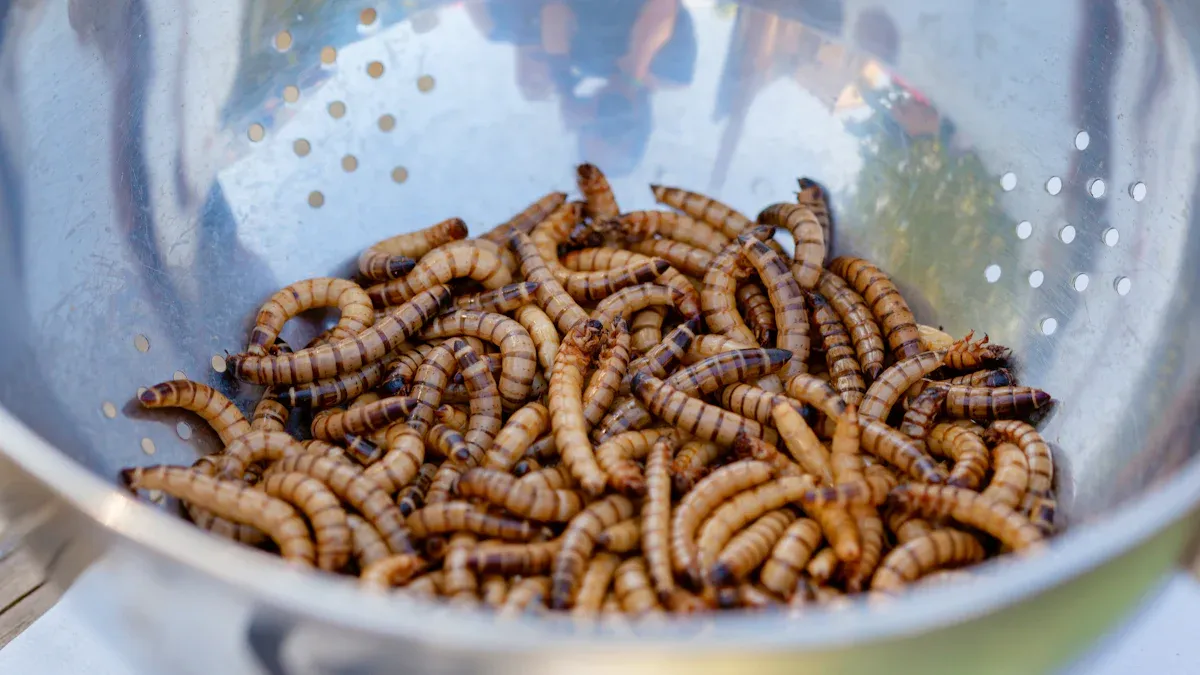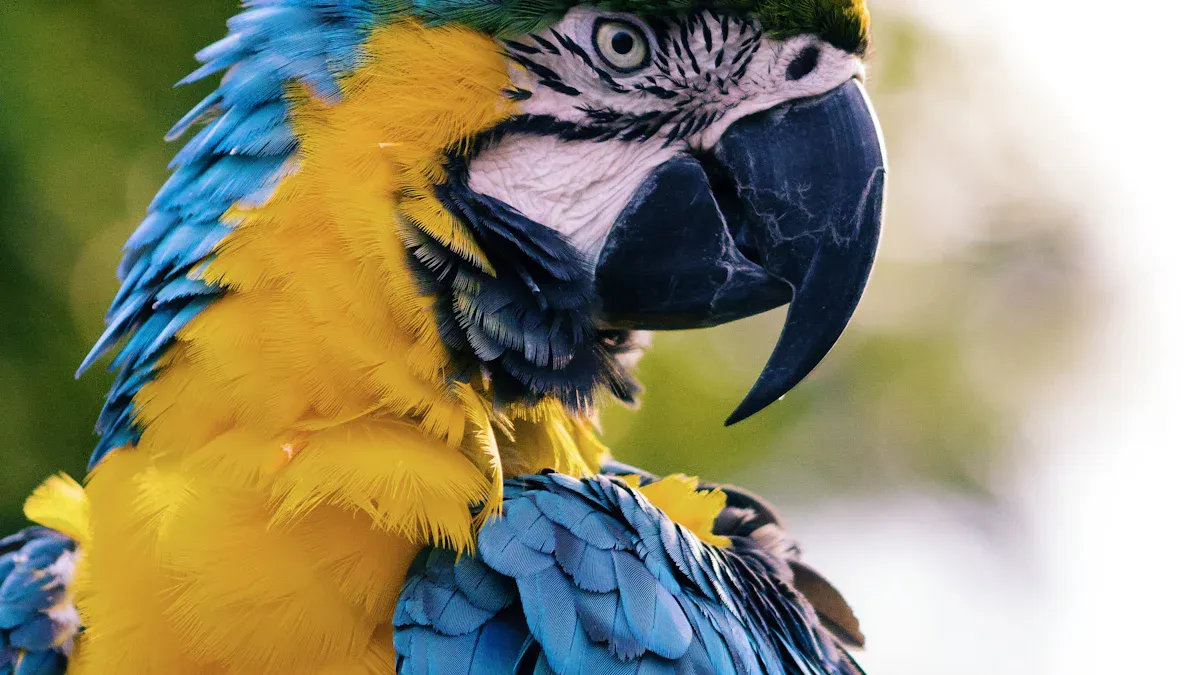
Mealworms for Parrots can make a great treat when used carefully. They bring protein and energy to a bird’s diet. Start with a small amount and watch how the parrot reacts. If any questions come up, an avian vet can help. Every parrot has its own needs.
Key Takeaways
- Mealworms provide parrots with important protein, fat, and minerals that support energy, muscle growth, and overall health.
- Introduce mealworms slowly and in small amounts, watching your parrot’s reaction to avoid digestive issues or allergies.
- Feed mealworms as an occasional treat, not daily, and adjust portion sizes based on your parrot’s species and size to keep their diet balanced.
Mealworms for Parrots: Benefits and Safety

Nutritional Value of Mealworms
Mealworms offer a strong nutritional boost for parrots. They contain high levels of protein and fat, which help support muscle growth and energy. Many bird owners look for new protein sources, and mealworms stand out because of their balanced profile. The table below shows how mealworms compare to other common protein sources:
| Protein Source | Crude Protein Content (%) | Fat (%) | Notes |
|---|---|---|---|
| Yellow Mealworm | 47-52 | 19 | High protein and fat, adjusted for chitin |
| Soybean Meal | ~49.4 | 1.5 | Plant-based, lower fat |
| Fishmeal | ~67.5 | 8-12 | Highest protein, moderate fat |
Mealworms also provide important minerals like iron, zinc, magnesium, and phosphorus. These nutrients help parrots stay healthy and active. The fat content in mealworms gives birds extra energy, which is especially helpful during cold weather or molting.
Tip: Dried mealworms are a first-class source of energy for birds. They are high in protein (over 50%) and rich in natural vitamins and minerals.
Suitability for Different Parrot Species
Mealworms for Parrots can work well for many species. Larger parrots, such as African Greys and Amazons, often enjoy the extra protein. Smaller parrots, like budgies and cockatiels, can also benefit, but they need smaller portions. Some parrots may not like the taste at first, so owners should introduce mealworms slowly.
- African Greys: Enjoy mealworms as a treat.
- Cockatiels: Can eat mealworms in small amounts.
- Budgies: Try tiny pieces or crushed mealworms.
- Macaws: Like the extra protein, but need moderation.
Every parrot is different. Some may love mealworms, while others may ignore them. Owners should watch their birds and adjust the diet as needed.
Potential Risks and How to Avoid Them
Mealworms for Parrots are safe when used properly, but there are a few things to watch out for. Too many mealworms can lead to weight gain because of the high fat content. Some parrots may have trouble digesting chitin, the tough outer shell of mealworms. Owners should always start with small amounts and watch for any changes in droppings or behavior.
- Feed mealworms as a treat, not a main food.
- Watch for signs of allergies or digestive upset.
- Store mealworms in a cool, dry place to prevent spoilage.
Note: If a parrot shows any signs of illness after eating mealworms, owners should stop feeding them and talk to an avian vet.
Choosing Live, Dried, or Freeze-Dried Mealworms
Parrot owners can choose from live, dried, or freeze-dried mealworms. Each type has its own benefits. Live mealworms can encourage natural foraging behavior, but they require more care and storage. Dried and freeze-dried mealworms are easy to store and serve. They keep most of their nutrients and are less messy.
Premium Quality Dried Mealworms make a great choice for many parrot owners. These mealworms are 100% natural and packed with protein and fat. They are also popular with wild birds and other insect-eating animals. Many people use them to attract robins, tits, and starlings to their gardens. Dried mealworms provide all the goodness of live mealworms without the hassle.
- Live mealworms: Good for enrichment, but need special care.
- Dried mealworms: Easy to store, high in nutrients, and convenient.
- Freeze-dried mealworms: Keep most nutrients, long shelf life.
Tip: Dried mealworms can be soaked in water to make them softer for smaller parrots or birds with sensitive beaks.
Mealworms for Parrots: Introduction and Best Practices
Step-by-Step Introduction Process
Introducing Mealworms for Parrots works best when done slowly and with care. Parrots can be picky, so a gentle approach helps them accept new foods. Here’s a simple way to get started:
- Offer a tiny amount of mealworm, either whole or crushed, mixed with your parrot’s favorite food.
- Watch how your parrot reacts. Some birds may show interest right away, while others need more time.
- Increase the amount gradually over several days if your parrot enjoys the taste and shows no signs of digestive upset.
- Always use mealworms from a trusted source. Commercially farmed mealworms are safest because they reduce the risk of parasites or contamination.
- For added nutrition, try dusting mealworms with a vitamin supplement or gut loading them with healthy foods like carrots before feeding.
Tip: Parrots need a variety of protein sources. Mealworms for Parrots should be just one part of a balanced diet that includes chopped egg, pellets, and fresh fruits and vegetables.
Portion Sizes and Feeding Frequency
Parrots come in many sizes, so portion control matters. Too many mealworms can cause health problems, especially for smaller birds. Veterinary nutritionists recommend feeding mealworms as a treat, not a main meal. Here are some general guidelines:
- Small parrots (budgies, cockatiels): 1-2 mealworms, 2-3 times per week.
- Medium parrots (conures, African Greys): 2-4 mealworms, 2-3 times per week.
- Large parrots (macaws, Amazons): 4-6 mealworms, 2-3 times per week.
Mealworms contain about 11% protein and 3% fat. Overfeeding can lead to weight gain or joint problems. Owners should avoid giving mealworms every day. Instead, use them as a special snack or training reward.
Note: Insects like mealworms may lack vitamins A and B1, so parrots need other foods or supplements to meet all their nutritional needs.
Monitoring Your Parrot’s Health and Behavior
When adding Mealworms for Parrots to the diet, monitoring health is important. Owners should look for changes in energy, feathers, and behavior. The table below shows what to watch for and how long changes may take:
| Metric | Timeline for Changes | Key Nutrients Involved | Signs of Improvement |
|---|---|---|---|
| Behavioral Changes | 1-3 days | B-vitamins, magnesium, electrolytes | More energy, active foraging, calmer mood |
| Body Fleshing | 7-14 days (initial) | Protein, lysine, methionine | Better muscle tone, healthy weight |
| Feather Quality | 2-4 weeks | Methionine, cysteine, biotin | Smoother, shinier feathers |
| Feather Color | 2-3 weeks | Carotenoids, iron, vitamin A | Brighter, richer colors |
| Egg Production | 7-14 days (initial) | Calcium, vitamin D3, protein | More eggs, fewer skipped days |
If a parrot shows any signs of illness, such as changes in droppings or loss of appetite, owners should stop feeding mealworms and contact an avian vet.
Preparation and Serving Tips
Preparing mealworms the right way keeps parrots safe and healthy. Here’s a step-by-step guide:
- Choose mealworms in the larval stage. Remove any that look damaged or are turning into pupae.
- Purge mealworms by withholding food for 1-2 days. This cleans their digestive tracts. Some owners flavor them with safe foods like carrot for extra nutrition.
- Freeze mealworms at -10° to -20° Celsius for 1-2 days. This ensures they are dead and hygienic.
- Serve mealworms in a clean dish. For smaller parrots, soak dried mealworms in water to soften them.
Premium Quality Dried Mealworms make serving easy. These mealworms are 100% natural, high in protein, and rich in vitamins and minerals. Many bird lovers use them to attract wild birds like robins and starlings, but they also work well for parrots. Dried mealworms store well and provide all the goodness of live mealworms without the mess.
Callout: Always wash your hands before and after handling mealworms. Clean your parrot’s food dish after each feeding to prevent bacteria growth.
Parrots thrive when owners introduce new foods slowly and watch for changes. Gradual dietary changes help balance nutrients and support healthy habits. Food-based enrichment, like foraging, keeps parrots active and happy. If a parrot acts differently, an avian vet can help guide the next steps.
FAQ
Can parrots eat dried mealworms every day?
Parrots should not eat dried mealworms daily. They work best as a treat two or three times a week. This keeps their diet balanced and healthy.
How should someone store dried mealworms?
Store dried mealworms in a cool, dry place. Use an airtight container. This keeps them fresh and safe for parrots and other birds.
Are dried mealworms safe for all parrot species?
Most parrot species can enjoy dried mealworms. Owners should start with small amounts and watch for any changes in their bird’s health or behavior.
Tip: Always check with an avian vet if unsure about new foods.


